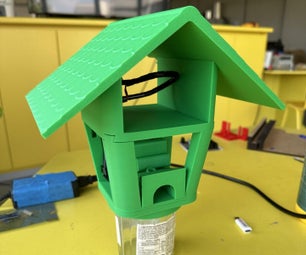Introduction: Measuring Inductance With a Multimeter and a Resistor
Background
From a very young age I was always interested in reusing, recycling, and re-inventing the ways things are utilized and in broadening their current use or finding new purposes. My main focus has always been electronics (audio electronics to be more precise, electric guitar equipment to be very specific). When I built my first tube amp I used 90% of recycled parts, and it sounded KILLER!.
If you have worked with electronic components you know that most of them (resistors, capacitors, vacuum tubes, etc.) are easy to identify. They are stamped with their denomination or values, they are color coded or you can directly measure them with a multi-meter.
The challenge comes with inductors and transformers. When you are reusing them from and old equipment you cannot be sure of their values. Even if you are using a new one, without the datasheet you are stuck.
I have used the simple method that I am about to describe and it worked for my application.
My idea is that although today, people in more developed places on earth, can buy equipment very easily (who doesn't have an oscilloscope or a signal generator, right?). Most of this "stuff" was not available when I was growing up, and is still not available in other places on earth. In the past, I did not own an Oscilloscope or and audio generator, so I will do without them. We should strive to do the best we can with what we have at hand.
Assumptions
This Instructable assumes that the reader has basic understanding of electronics and its main governing laws: Ohm and Kirchhoff.
Although I will state some of the principles used for the calculations, I recommend reading about electrical circuit theory for a deeper understanding on them.
Objective
The goal of this Instructable is to present a simple and proven method to indirectly determining the inductance of a filter choke (inductor).
Expectations
The expectation is to obtain a value of the component that can be used in your designs. It will only determine the L value of the inductor. This method will not determine maximum current, maximum dielectric isolation values, maximum input voltages, power, etc. The size of the inductor and the application from which your are taking it from to be reused can give you an idea of maximum power and current, but I am not going there in this Instructable.
Considerations
The calculated result will be a very close approximation to the real value, we are not looking for to the 5th most significant digit, OK? :)
The vast majority of the components being used are rated at 5% tolerance. Even better: most filter inductors (chokes) are rated at plus/minus 20% of the nominal value as per manufacturer datasheets. In summary: methodological errors laying within +/- 20% range of calculated value are considered acceptable to me.
For example: When adding 2 quantities, if one of them has a value smaller than 10% of the other, I will discard it as "non significant for any practical purposes".
During the calculations I will point to this by saying: Due to the fact that A is more than 10 times bigger than B, if A+B=C I assume that C is approximately equal to A hence discarding B in the calculations.
Tools, instruments, materials, etc.
For these measurements we need:
- a known reduction transformer (120/240V to 6/12V or whatever you have at hand).
- a potentiometer (I recommend something in the 10K to 100K Ohm linear range)
- a multimeter
- The components to be tested :)
All the calculations will be done at 60Hz, which is the standard household AC frequency in the US, but you can change the calculations to the frequency of your country.
Warning: We are dealing with Potentially Hazardous Voltages and Currents here. Please do not try any of these tests if you are not familiar with safety procedures. BE SAFE!
Step 1: Determining the Inductance
As said before I will focus in audio applications. The 60Hz AC that we get from the power grid is at a perfect frequency for this purpose.
Steps
1) With the multi-meter set to Ohms, measure the resistance between the terminals of the inductor. You will be measuring the real value of the parasitic resistance of the inductor winding. Write it down somewhere :) (Note: in my case R=300.8 Ohms). See pictures.
2) The diagram of the circuit that we are going to use for the test is shown above.
3) Connect the circuit without plugging it to the power outlet.
4) Set the potentiometer to its maximum value (this is good practice, you start by presenting the maximum impedance to the power supply thereby minimizing the current, and move down the impedance from there)
5) Connect the circuit to the power outlet.
6) With the multi-meter set to AC voltage measure the Voltage between terminals of both the Resistor (VR) and the inductor (VL).
7) Move the potentiometer until the read of VR equals VL. See pictures (readings of 9.22V and 9.17V)
8) Turn off the power
9) Disconnect the potentiometer gently so you don't change its value.
10) With the multi-meter set to Ohms measure the value of the potentiometer.
11) If the value read in 10 is more than 10 times bigger than the value read in 1 then discard the inductor resistance in the calculation. Note: If it is not, you will need much more theory, mathematics and calculus to determine L.
12) Using the formula L = R / (6.28 x 60 Hz) you will get an approximate value for L. In my case the potentiometer value was 4060 Ohms.
R = 4060 Ohms => L = 4060 / 377 => L = 10.77 H.
Note 1:In my test I used a known inductor with the manufacturer label on it to show the validity of the method. The sticker in the inductor reads: L = 9H +/- 15% with a winding resistance of R=300 Ohms. Our measurement of internal resistance (step 1) was 300.8 and our L calculation comes very close to the upper limit of the manufacturer specs which is 10.35 H.
Note 2: If you are interested in some of the theory behind this method please continue until the end of the instructable.
Step 2: Theory Behind the Estimation of the Inductor Value
The equivalent circuit of a physical (real) inductor is represented by an inductor in series with a resistor and a capacitor in parallel. Fig 1.
At audio frequencies we can assume that the parasitic capacitance will be insignificant and discard it for practical purposes. The new equivalent circuit is an inductor with a resistor in series. Fig 2.
In summary the circuit used for the test is shown in Fig 3.
Kirchhoff's voltage law (KVL) says that "the algebraic sum of all voltages in a loop must equal zero".
Eq.1) V+VR+VL=0
Where V is the power supply voltage, VR is the voltage between the resistor (potentiometer) terminals, and VL is the voltage beween the inductor terminals.
Note: I will use CAPITAL letters V for Voltage and I for Current even though they are both alternate signals. For practical purposes I will not differentiate between Peak Values vs RMS. The multi-meter measures RMS, and this is the value that is required for the calculations.
Ohms law says that:
Eq.2) V = I * Z
Where V is the voltage between terminals of the measured component, I is the current through the component, and Z is the impedance.
Replacing Eq. 2 in Eq. 1 we get:
Eq.3) V + IR * ZR + IL * ZL = 0
ZL is the impedance of the Inductor determined by the equation
Eq.4) ZL= j w L
For a resistor (assumed ideal) Z = R. In a series circuit, by definition, the current is the same throughout. Then: IL = IR replacing in Eq. 3 we get:
Eq.5) V + I * ZL + I * R = 0
Method
The method consists in changing the value of R (the potentiometer) until the measured VR is equal to the measured VL. VR and VL will have the same “Value” but their “Phase” will be different. The voltage applied by the power transformer is not important and will not be part of the calculations from now on. Also, the phase is not important to the calculation of L. If the phase is not considered, j does not have any meaning, then:
|VR| = |VL| => I * R = I * w L =>
I am using brackets for the voltages to represent that I am not considering the phase change between Voltage and Current due to the inductor. I recommend reading about circuit theory, for a deeper understanding on that matter.
In Summary, when |VR| = |VL|:
Eq.6) R = w L
By definition w = 2 x Pi x Freq =>
Eq.7) R = 2*Pi*F*L
2 Pi aprox 6.28, then the equation that we are looking for is:
Eq.8) L = R / (6.28 x 60Hz)
Which is the equation that we used in Step 1 when calculating the inductor "L" value.

Runner Up in the
Electronics Tips & Tricks Challenge











